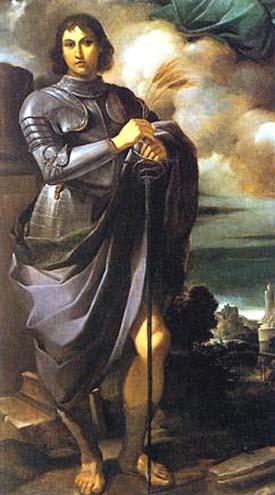The most basic type of St. Pancras image is like the one at right: a beardless youth in boots, a tunic, and something like a toga points to Heaven with his right index finger and holds in his left hand a palm branch and a book. Tbe book will have the words VENITE AD ME ET DABO VOBIS OMNIA BONA, "Come to me and I shall give you all good things." No such phrase is found in scripture, nor in the vitae and other memorials of Pancras collected in the Acta Sanctorum and the Golden Legend. It appears to be a combining of Matthew 11:28 ("Come to me, all you that labour…and I will refresh you) with 24:47 (where the master puts the faithful servant super omnia bona, "in charge of all good things").
In a second type of image St. Pancras will also have a sword, the implement of his martyrdom, as in the second picture at right. That picture also exemplifies a practice in the Renaissance of putting him in sumptuous contemporary dress.
In the third type the saint is erroneously portrayed as a soldier, with the sword serving as an emblem of his profession, as in the third picture. This error may be due to a misreading of earlier images with the sword, especially as his feast day is shared with the military saints Nereus and Achilleus.
St. Pancras is beardless in all his images, but as the second and third pictures show, there is a tendency to make him look rather more than 14 years of age.
Prepared in 2014 by Richard Stracke, Emeritus Professor of English, Augusta University. Revised 2019-08-19.
HOME PAGE

20th-century statue in Barcelona (See description page)

St. Pancras as Wealthy Youth with Sword (See description page)

As a young soldier (See description page)
ATTRIBUTE
- Sword
DATES
- Feast day: May 1
- The Golden Legend and its source make St. Pancras 14 years old when he was martyred. The former puts that death in the year 287; the latter, in the 9th year of Diocletian and 8th of Maximian (i.e., 293).
- The Acta Sanctorum's commentary on the Latin life suggests the martrydom may have occurred as late as 304 (May vol. 3, 17).
MORE IMAGES
- 12th century: A mosaic in Sicily presents St. Pancras in the Orthodox style.
- 1443: In Vivarini's Polyptych of the Body of Christ St. Pancras is one of the four martyred saints who flank the image of the Man of Sorrows.
NAMES
- Also known by his Latin name, Pancratius
BIOGRAPHY
- Golden Legend #76.
- Acta Sanctorum, May vol. 3, 17-22. The Acta printed at pages 21-22 is closely related to the Golden Legend's source.
- Carolus de Smedt, Josephus de Backer, Franciscus van Ortroy, and Josephus van den Gheyn, "Passio S. Pancratii," Analecta Bollandiana, X, 53-56.